Key takeaways:
- Effective communication encompasses both verbal and non-verbal cues, essential for collaboration and clarity on set.
- Listening actively and fostering an open environment encourages creativity and team morale.
- Common barriers include misunderstandings, noise, and emotional stress; addressing them is crucial for smooth production.
- Building rapport through personal interactions and expressing gratitude enhances team dynamics and promotes a positive atmosphere.
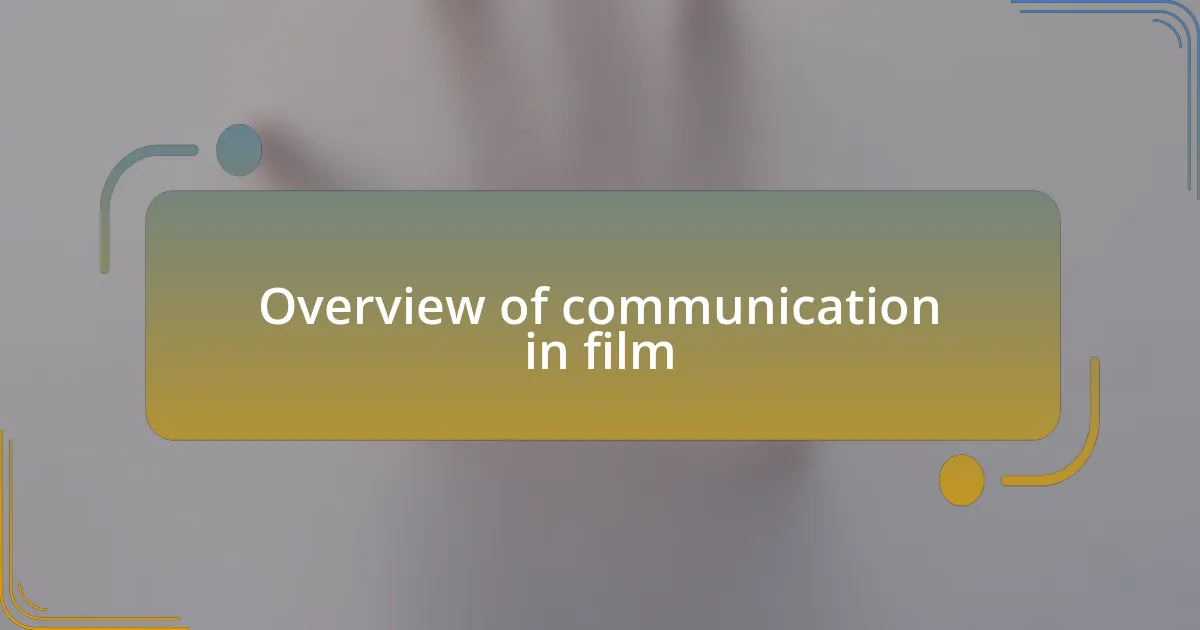
Overview of communication in film
Communication in film is not just about spoken words; it’s a symphony of visual and verbal interactions that align the entire crew toward a common vision. I remember my first day on set, feeling the buzz of excitement yet nervousness. I quickly realized that understanding non-verbal cues—like a director’s glance or a gaffer’s nod—was as vital as any dialogue.
In this fast-paced industry, clarity is paramount. Miscommunication can lead to costly delays and compromised creativity. For example, during a particularly chaotic shoot, I learned that a simple misunderstanding over shot timing created a ripple effect that stalled production. Have you ever experienced something similar? Those moments remind me that effective communication is the backbone of a successful film project.
Listening actively is a skill that can elevate any collaboration. Engaging with team members by asking for their input not only fosters trust but often brings fresh perspectives to the table. I find great joy when a crew member’s insight sparks a brilliant idea—it’s those collaborative moments that truly enrich the filmmaking experience.

Importance of effective communication
Effective communication on set goes beyond sharing information; it builds a foundation of trust and collaboration. I recall a time during a critical scene when I misinterpreted the director’s instructions. The confusion led to frustration among the team, turning a vibrant energy into tension. It made me realize how crucial it is to clarify intentions promptly—being on the same page can make all the difference in achieving our artistic vision.
Moreover, the emotional dynamics of a film set hinge on communication. I remember a particularly emotional scene where the actors were vulnerable. Clear, encouraging feedback from the director helped them feel safe to explore their characters deeply. This said, how can we ensure that every crew member feels empowered to express their ideas? By maintaining open channels and actively inviting input at every stage, we create an environment where creativity thrives.
Ultimately, effective communication can transform the atmosphere of a set. I’ve often witnessed how a simple “thank you” or a genuine compliment can lift team morale during long hours. Have you ever noticed how positivity spreads in a collaborative space? It’s fascinating to see how clear, respectful communication fosters not just productivity, but a genuine camaraderie among crew members, turning long, challenging days into rewarding experiences.
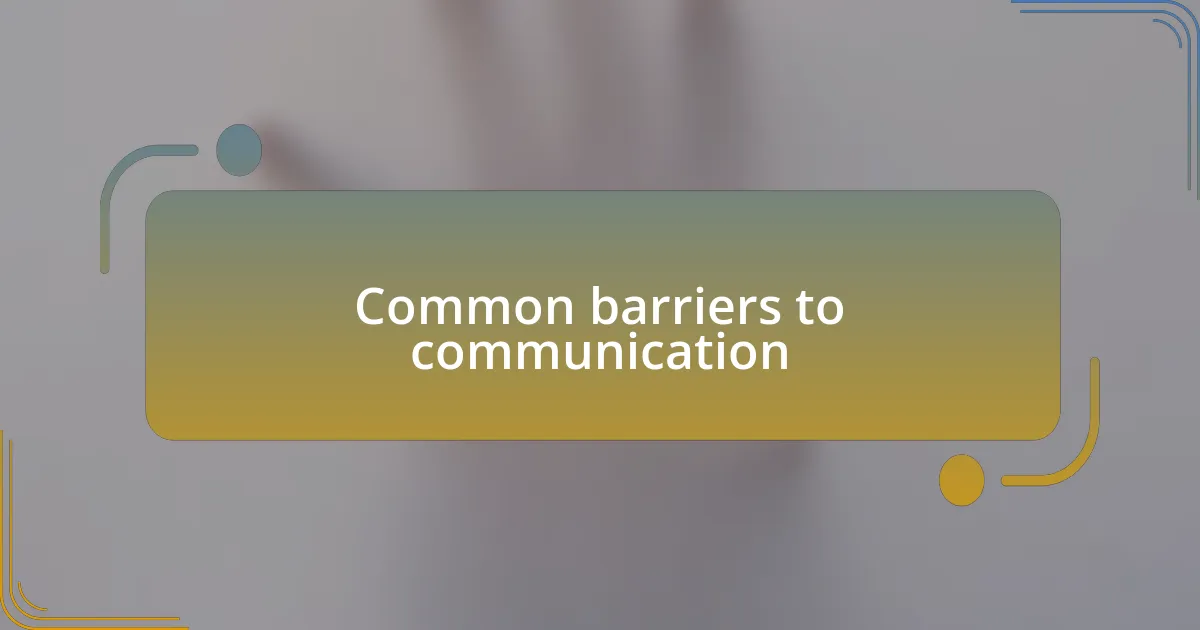
Common barriers to communication
Misunderstandings often serve as significant barriers to communication on set. I once experienced a situation where the production assistant misheard the cue for a camera angle, leading to a last-minute scramble that put unnecessary pressure on the entire crew. It’s interesting how a single miscommunication can ripple through the workflow, isn’t it? This highlights the importance of confirming details, especially in a fast-paced environment where every second counts.
Another common barrier is the noise and hustle of a busy set, which can drown out vital conversations. I remember standing next to a generator while discussing an actor’s performance with the director. It forced me to constantly repeat myself, leading to misunderstandings that could have easily been avoided. In an industry where clarity is paramount, learning to find quieter moments for critical discussions can significantly improve understanding.
Emotional barriers can also impede communication. I’ve seen how stress or anxiety can prevent team members from voicing concerns or asking for clarification. Just last week, during a high-pressure shoot, a crew member hesitated to voice their opinion on a safety issue because they were worried about overstepping. This made me wonder how often we let fear stifle our voices on set. Building a supportive environment encourages everyone to speak up, ultimately leading to a safer and more cohesive production.
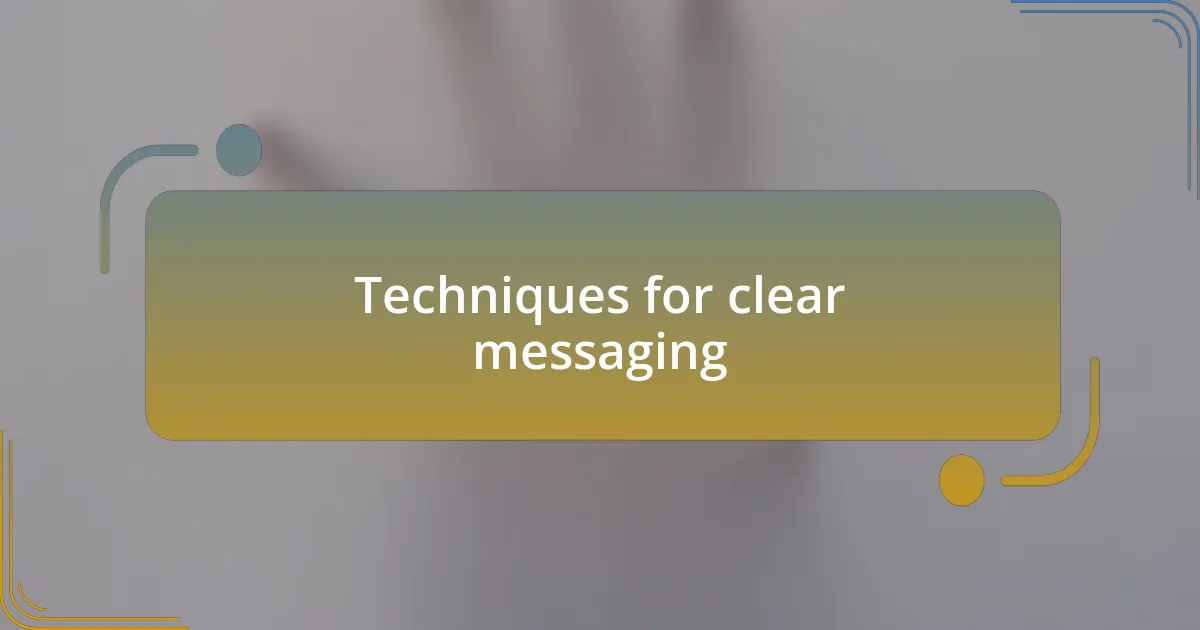
Techniques for clear messaging
When it comes to clear messaging, I’ve found that using straightforward language is essential. I remember once having to explain a complex lighting setup to an inexperienced intern using overly technical jargon. Their confused expression made me realize that simplicity can be more effective than depth in certain conversations. Clear, concise language ensures everyone grasps what’s being communicated, even if they’re not experts in that area.
Additionally, active listening plays a crucial role in conveying messages effectively. During a particularly hectic shoot, I focused on truly understanding what my team members were saying rather than just waiting for my turn to speak. This shift in perspective not only led to fewer mistakes but also fostered a sense of trust among us. Have you ever experienced a moment where someone’s full attention made all the difference? It inspired me to be more present in conversations.
Visual aids can also enhance communication. I recall a challenging coordination meeting where a simple storyboard transformed our discussions. When we could see the visual direction, ideas started flowing more freely. It made me realize that sometimes, a picture really is worth a thousand words. Using diagrams or sketches can bridge communication gaps, especially when language fails us or when dealing with abstract concepts.
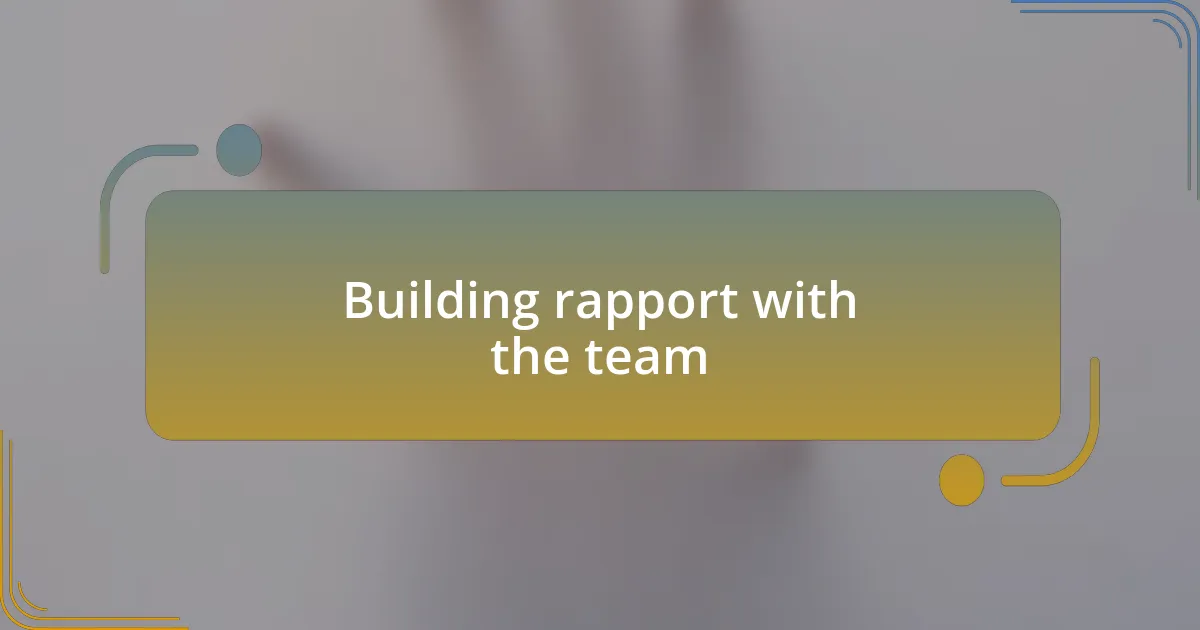
Building rapport with the team
Building rapport with your team is a foundational aspect of effective communication. I remember my first few days on a new film set, feeling the tension and uncertainty in the air. I made it a point to greet each team member personally, asking about their experiences and sharing a bit about myself. Those small interactions created an inviting atmosphere, making it easier for us all to collaborate. How much easier could your workday be with a few friendly conversations?
Another key element is finding common ground. During a particularly challenging production, I sought feedback from the crew over lunch, discovering shared hobbies and interests. Those moments of connection not only lightened the mood but also strengthened our teamwork. Have you ever found that shared interests can turn strangers into allies? It’s fascinating how knowing a little about each other can foster an environment where everyone feels valued.
Lastly, I’ve learned that showing genuine appreciation goes a long way. After wrapping a long day, I made it a habit to acknowledge individual contributions, whether big or small. Watching my team light up with gratitude was a reminder that recognition nurtures a positive culture. When was the last time you expressed gratitude in your workplace? It’s a simple act, yet it can lead to a significant shift in team dynamics.
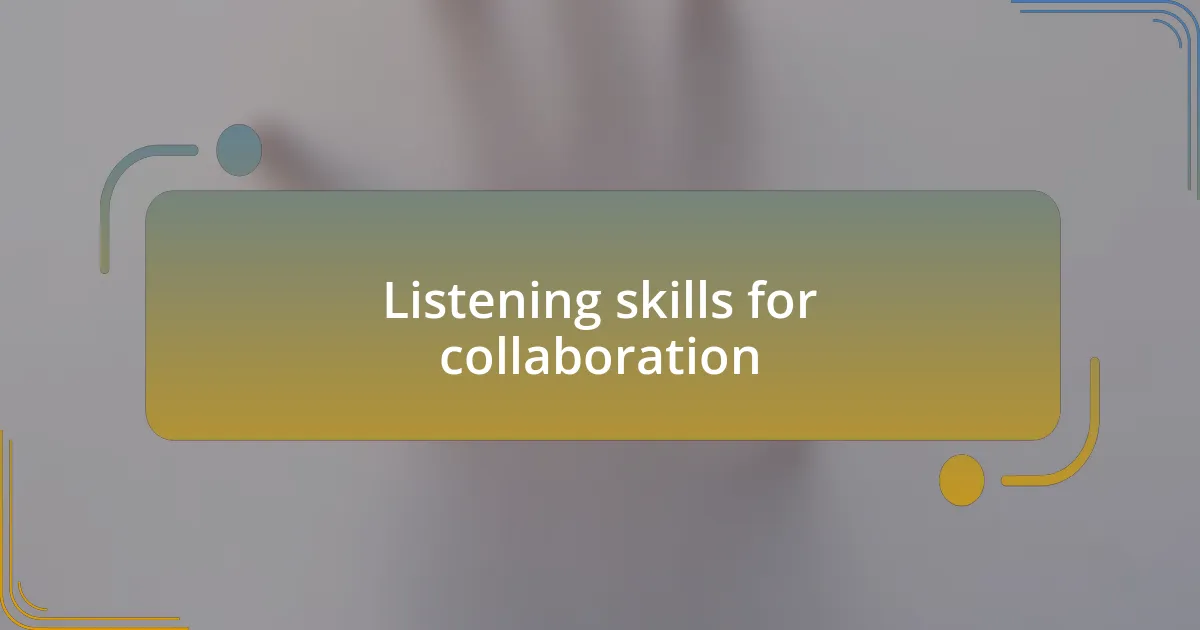
Listening skills for collaboration
Effective listening is a cornerstone of collaboration on set. I recall a time when a new director joined us for a project; initially, I noticed he spent more time talking than truly hearing his team. Once he shifted his approach and started actively listening, the conversations became richer, and everyone’s ideas flourished. Have you ever seen a project transform just because someone took the time to listen?
Moreover, when I was a part of a tight-knit crew, I learned the importance of not just hearing words but understanding emotions behind them. In a heated moment, one of my colleagues expressed frustration about a scene during a read-through. Instead of brushing it off, I reflected on his concerns and realized he just wanted to be heard and supported. That simple act of listening created a stronger bond among us, which ultimately led to a more creative atmosphere. Isn’t it remarkable how empathy can change the dynamics of a team?
In my experience, asking open-ended questions has been an invaluable listening strategy. During the early stages of production, I often prompted discussions by saying, “What do you think could work better?” This encouraged my teammates to share their insights freely, which not only enhanced our problem-solving but also fostered a sense of ownership among everyone involved. How often do you invite feedback in your collaborative efforts? The responses can surprise you and lead to unexpected breakthroughs.
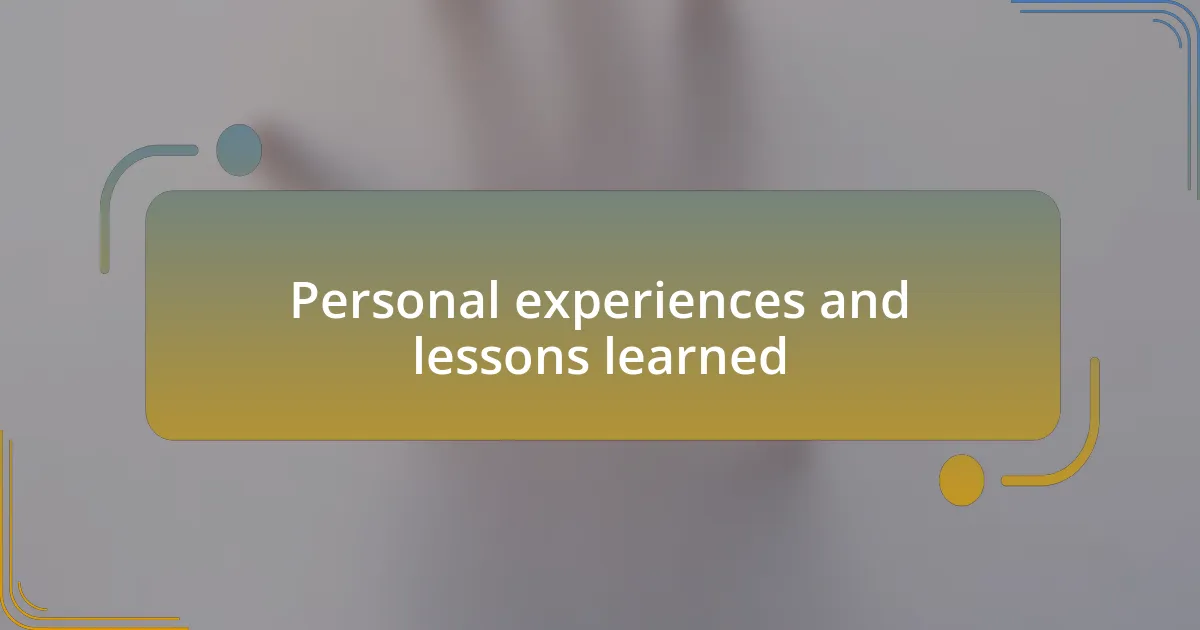
Personal experiences and lessons learned
I remember a time on set when a conflict arose between the cinematographer and the gaffer over lighting choices. Rather than avoid the tension, I facilitated a candid conversation where each could express their vision. Watching them move from frustration to understanding was enlightening; it reinforced for me that open dialogue not only resolves issues but ignites creativity as well.
One lesson that stands out is the significance of body language in communication. During a particularly intense shoot, I noticed the way I positioned myself directly across from a team member made them more defensive. By simply shifting to a more open stance, I could see their demeanor change and our discussion became much more productive. Have you considered how your physical presence could impact communication?
Lastly, I’ve come to appreciate the power of gratitude on set. After completing a long day, I started making it a habit to thank each crew member for their contributions. This small gesture transformed the atmosphere; colleagues felt valued and respected, which in turn boosted morale. It’s fascinating how something as simple as gratitude can strengthen relationships and foster a collaborative spirit. Have you ever expressed appreciation in your work environment?